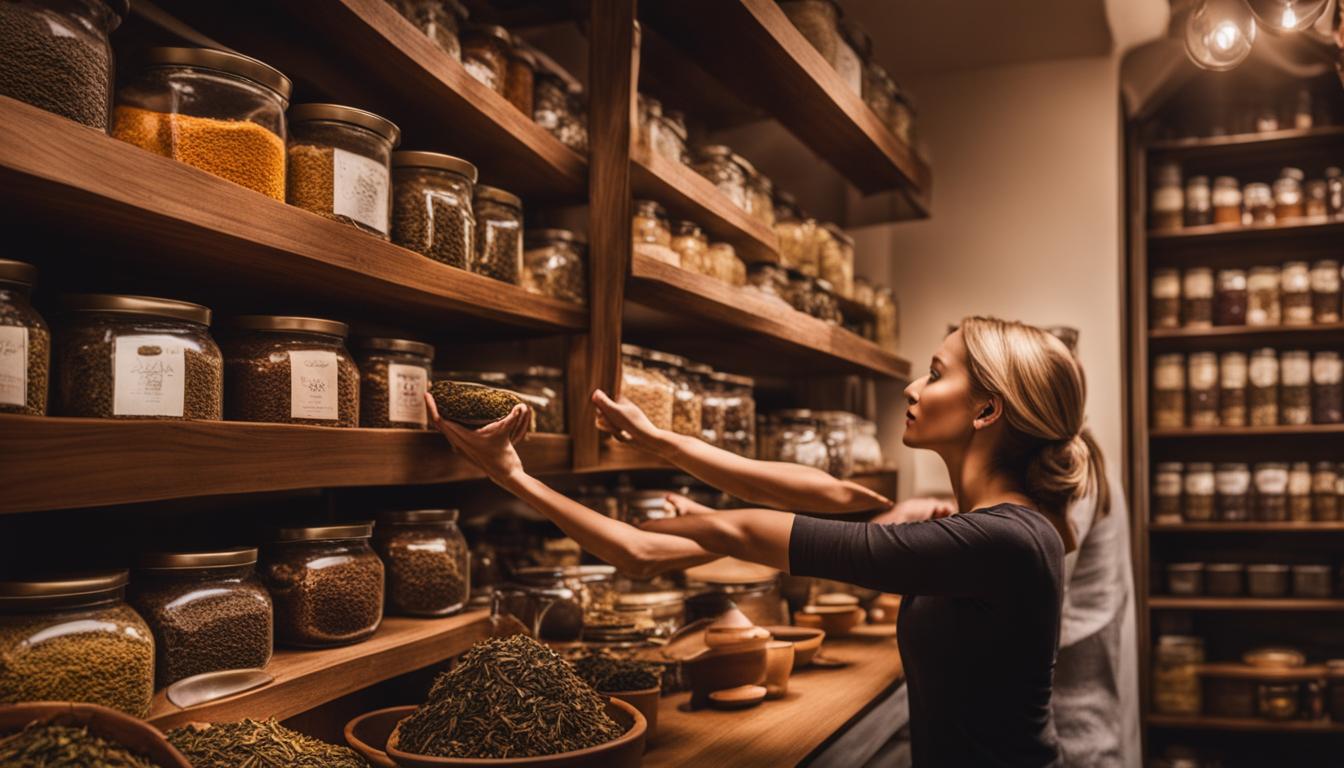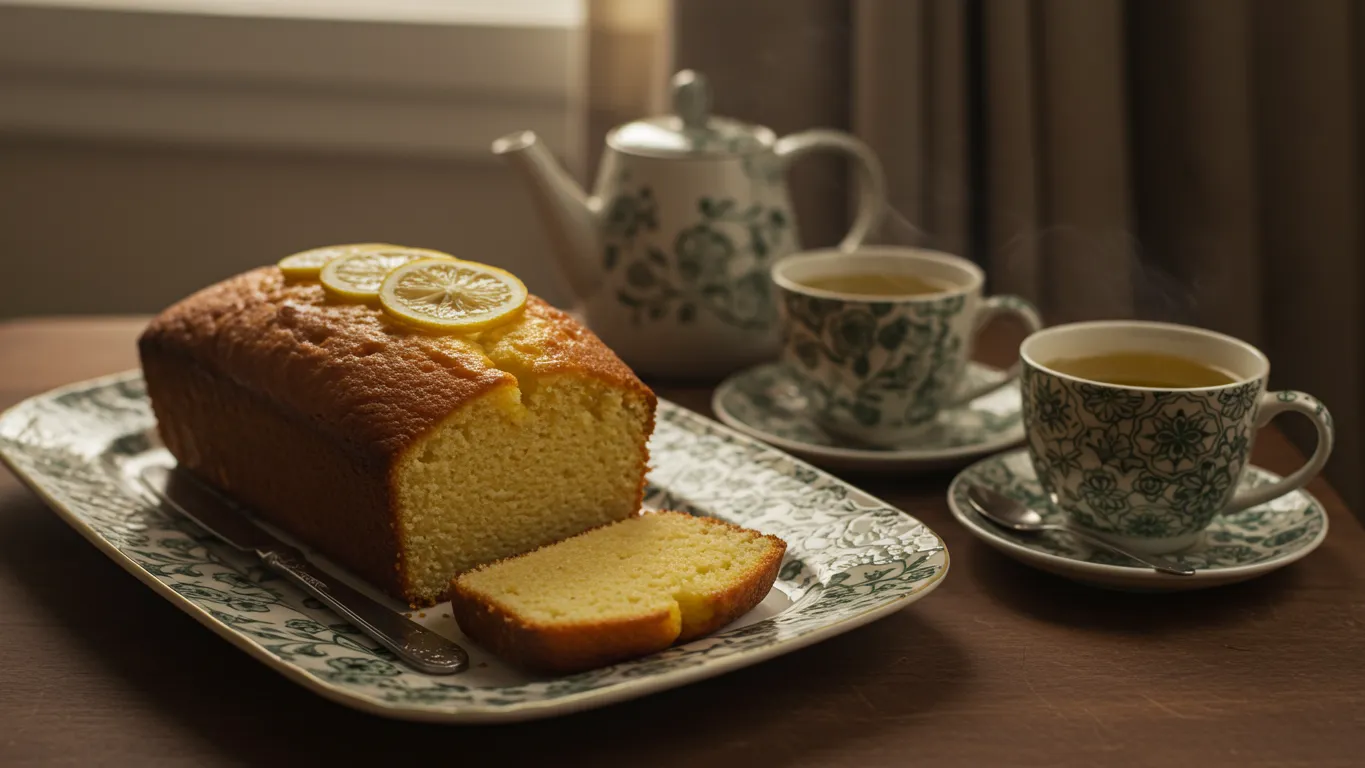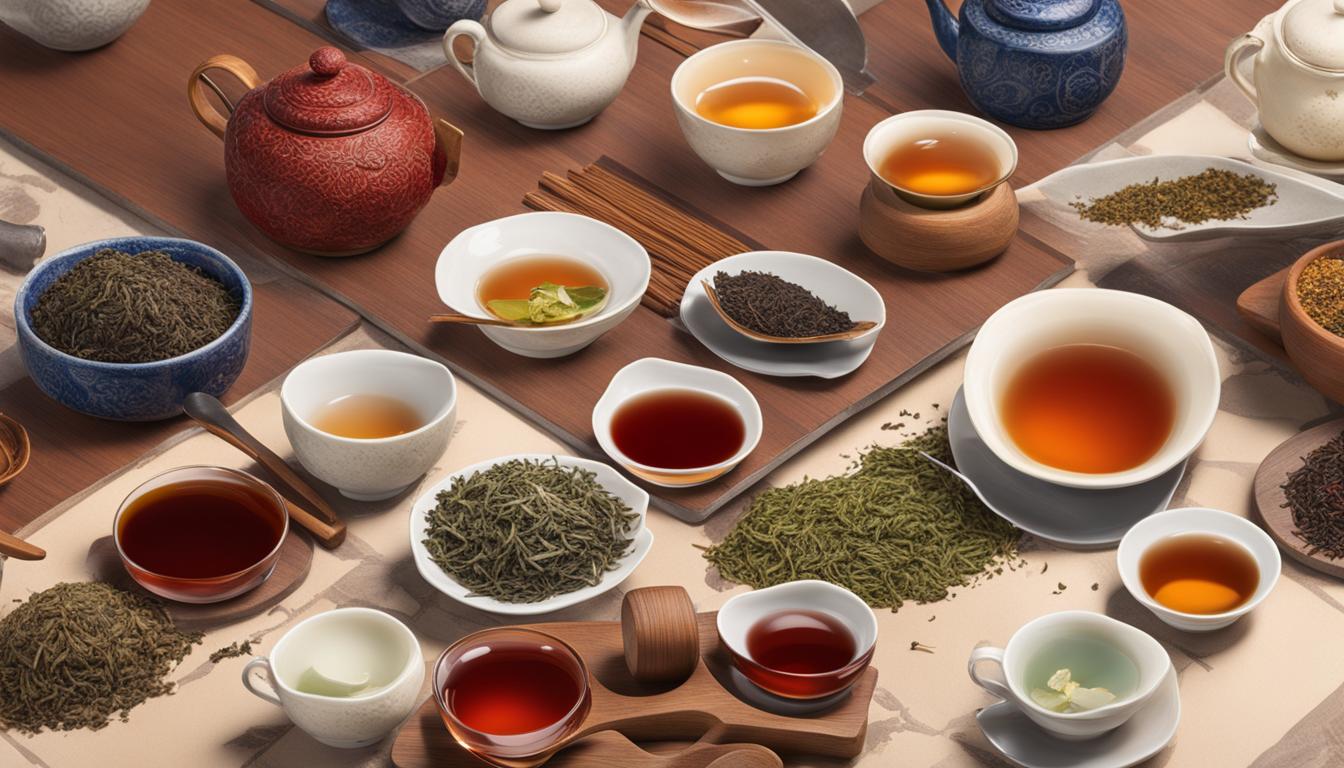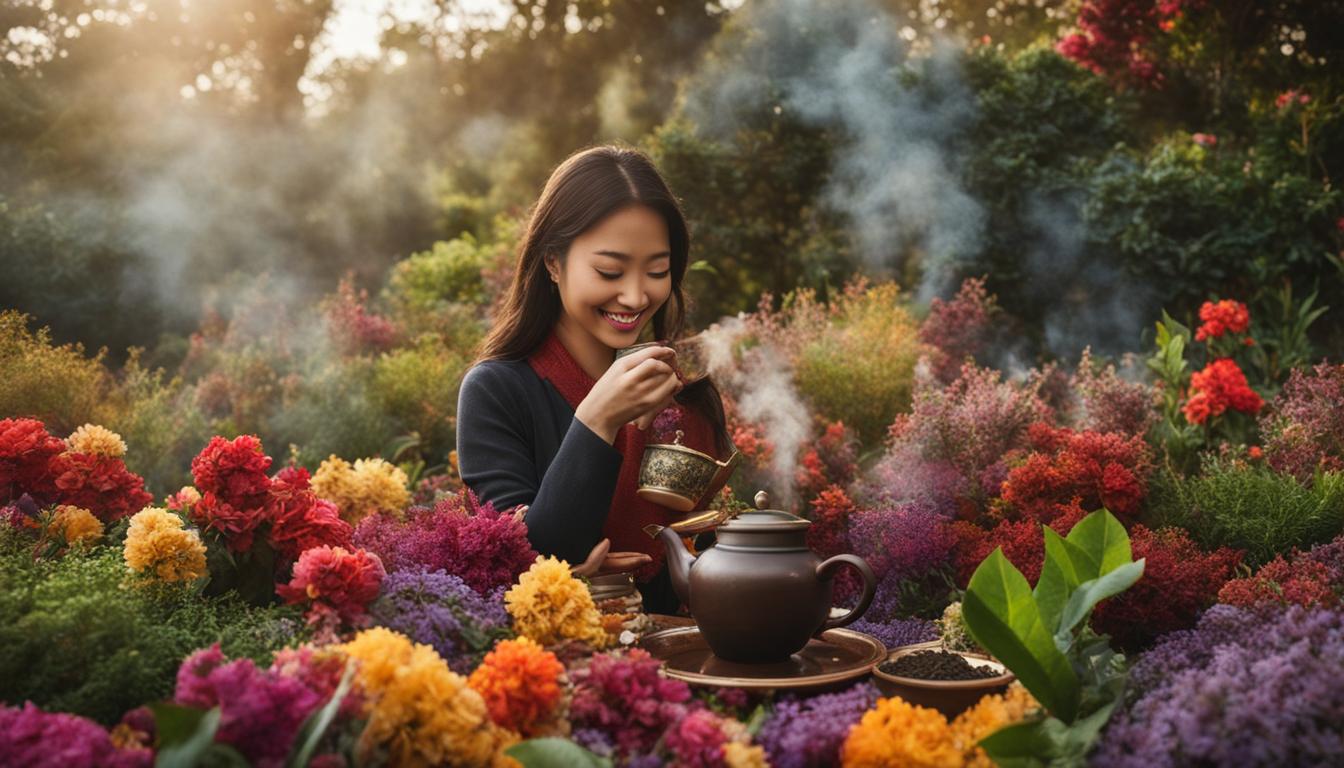Choosing the perfect tea to complement your meals is an art that can elevate your dining experience to new heights. Whether you’re indulging in spicy dishes, exploring ethnic cuisines, or savoring seasonal delights, the right tea can enhance the flavors and create a harmony between your food and drink. Join us as we embark on a journey of tea selection, unlocking the secrets to pairing teas with different cuisines, exploring flavors for different seasons, and even enhancing wellness through tea selection.
Key Takeaways:
- Choosing the right tea can enhance the flavors of your meals.
- Pair teas with different cuisines to create a harmonious balance.
- Explore tea flavors that match the seasons for a delightful experience.
- Select teas known for their health benefits to enhance your well-being.
- Discover the world of flavored teas and indulge in unique taste combinations.
The Art of Brewing Tea
Proper tea preparation is an essential skill for any tea lover. Each type of tea requires a specific brewing method to bring out its flavors and aromas. Let’s explore the art of brewing different teas:
Black Tea:
Black tea is made from the dried leaves of the Camellia sinensis plant and is known for its rich and robust flavors. To brew a perfect cup of black tea, start by boiling water to a temperature of 200-212°F (93-100°C). Steep the tea leaves for 3-5 minutes, depending on your desired strength. Remember, black tea can become bitter if steeped for too long.
Green Tea:
Green tea is known for its refreshing taste and numerous health benefits. To brew green tea, heat water to a temperature of 170-180°F (77-82°C). Steep the leaves for 2-3 minutes to avoid any bitterness. Because green tea leaves are delicate, be careful not to use boiling water as it can scorch the leaves and affect the taste.
White Tea:
White tea is the most delicate type of tea and requires a gentle brewing method. Heat water to a temperature of 160-170°F (71-77°C). Steep the leaves for 1-2 minutes to extract the subtle flavors. White tea should be brewed for a shorter time to avoid overpowering its delicate taste.
Oolong Tea:
Oolong tea offers a wide range of flavors and falls between black and green teas in terms of oxidation. Heat water to a temperature of 180-200°F (82-93°C) and steep the leaves for 3-5 minutes. The steeping time can vary depending on the desired strength and flavor profile of the oolong tea.
Herbal Tea:
Herbal teas are made from botanicals and fruits and offer caffeine-free options. The brewing method for herbal teas can vary depending on the ingredients used. In general, heat water to a temperature of 200°F (93°C) and steep the herbs or fruits for 5-7 minutes to extract their flavors fully.
Iced Tea:
Iced tea is a popular choice for refreshment, especially during hot summer months. To make iced tea, start by brewing a stronger concentration of tea. Double the amount of tea leaves and steep them for the same amount of time as you would for hot tea. Once brewed, pour the tea over ice and let it cool. Serve with your favorite garnishes and enjoy!
Brewing tea is an art that allows us to experience the full range of flavors and aromas that each tea has to offer. By understanding the proper brewing methods for different types of tea, we can ensure a perfect cup every time. So grab your favorite tea leaves, follow these brewing techniques, and savor the delightful experience of a well-brewed cup of tea.
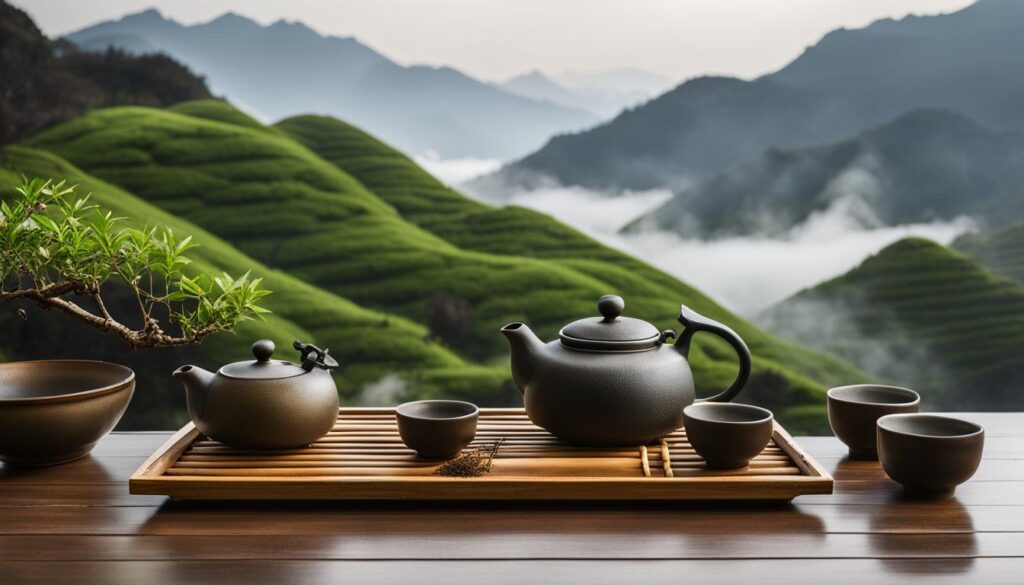
Pairing Tea with Different Cuisines
In the world of culinary delights, tea has the power to elevate the flavors of any cuisine. Whether you’re indulging in seafood meals, meat-based dishes, ethnic delicacies, or health-conscious options, the right tea pairing can take your dining experience to new heights. Let’s explore how to match teas with various cuisines and create harmonious flavor combinations.
The Power of Tea Pairing
When it comes to seafood meals, lighter teas like green or white tea are the perfect choice to complement the delicate flavors. The subtle notes of these teas enhance the natural sweetness of seafood, creating a delightful balance on your palate. For meat-based meals, black teas with their robust flavors add a bold contrast. The richness of black tea pairs exceptionally well with the heartiness of meats, creating a symphony of flavors.
Tea has the power to enhance the flavors of any cuisine, whether you’re enjoying seafood, meat-based dishes, ethnic delicacies, or health-conscious meals.
Exploring ethnic cuisines opens up a world of exciting tea pairing possibilities. Consider the dominant flavors and spices in the cuisine and choose a tea that enhances those elements. For example, if you’re enjoying Indian cuisine with its fragrant spices, a robust chai tea can elevate the overall dining experience. For health-conscious meals, herbal teas offer a wide variety of flavors without the caffeine, allowing you to enjoy the benefits of tea while sticking to your dietary goals.
Creating Flavor Harmony
Pairing tea with different cuisines is all about creating flavor harmony. Just as spices and ingredients are carefully selected to complement each other in a dish, tea can play a similar role. By considering the flavor profiles of teas and cuisines, you can create exquisite taste combinations that truly elevate your dining experience. Whether you prefer light and delicate notes or bold and robust flavors, there’s a tea out there waiting to be paired with your favorite cuisine.
| Cuisine | Recommended Tea Pairing |
|---|---|
| Seafood | Green or White Tea |
| Meat-based | Black Tea |
| Ethnic | Chai or Country-Specific Teas |
| Health-conscious | Herbal Teas |
Remember, the key to successful tea pairing is experimentation. Don’t be afraid to try different teas with your favorite cuisines to discover your personal taste preferences. With the right tea pairing, every dining experience can become a delightful journey of flavors and aromas.
Tea Selection for Different Meal Courses
Tea is not just a beverage to enjoy on its own; it can also be a delightful accompaniment to each course of your meal. Whether you’re starting with appetizers, indulging in main courses, or treating yourself to desserts, there’s a perfect tea to complement every dish.
Tea for Appetizers
When it comes to appetizers, lighter teas with delicate flavors work best to awaken the palate. Green tea or white tea, with their refreshing and subtly grassy notes, make an excellent choice. These teas cleanse the palate between bites and prepare it for the flavors to come.
Tea for Main Courses
When selecting tea for main courses, consider the intensity and flavors of the dish. For lighter dishes, like salads or seafood, a green tea or oolong tea can provide a complementary balance. The earthy notes of oolong tea can enhance the umami flavors in savory dishes. If you’re enjoying a rich and hearty main course, black tea pairs wonderfully with its bold and robust flavor.
Tea for Desserts
Tea and desserts are a match made in heaven. For sweet treats, choose teas with sweet or floral notes that can enhance and complement the richness of the desserts. Black teas with hints of chocolate or caramel make a decadent pairing. Alternatively, floral teas like jasmine or rose can add a delicate touch to light and fruity desserts.
| Course | Recommended Tea |
|---|---|
| Appetizers | Green Tea or White Tea |
| Main Courses | Green Tea or Oolong Tea (for lighter dishes) Black Tea (for rich and hearty dishes) |
| Desserts | Black Tea with Sweet or Floral Notes |
By selecting teas that harmonize with each course of your meal, you can create a cohesive and enjoyable dining experience. Don’t hesitate to experiment with different tea flavors and pairings to discover your personal favorites. Cheers to elevating your meals with the perfect cup of tea!
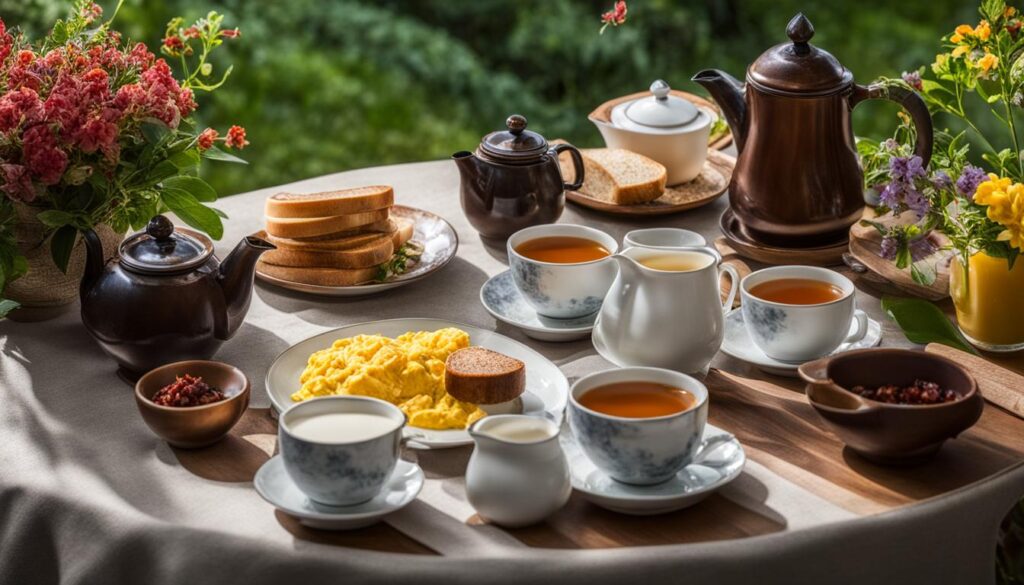
Exploring Tea Flavors for Different Seasons
Tea flavors can change with the seasons, offering a delightful way to enhance your daily tea ritual. Each season has its own unique characteristics and flavors that can be celebrated and complemented with the right choice of tea. Whether you’re looking for a refreshing iced tea for summer, a warming brew for winter, a floral infusion for spring, or an earthy blend for fall, there’s a tea to suit every season’s mood and ambiance.
During the scorching summer months, a chilled glass of iced tea can be a refreshing and revitalizing choice. Opt for fruit-infused iced teas like peach or raspberry, which offer a burst of fruity flavors and a cooling effect. These teas are perfect for quenching your thirst and providing a delightful respite from the heat.
In contrast, when winter arrives with its chilly winds, a steaming cup of black tea or spiced chai can bring comfort and warmth. These robust teas, with their rich flavors and aromatic spices, are perfect for cozying up by the fireplace and indulging in moments of relaxation.
As spring emerges with its blooming flowers and fresh scents, lighter and more delicate teas come to the forefront. Floral teas, such as jasmine or rose, offer a fragrant and elegant experience that evokes the essence of the season. Sipping on these teas can be a delightful way to embrace the rejuvenating spirit of spring.
Lastly, as the leaves change color and fall settles in, teas with earthy and warming flavors take center stage. Oolong tea or chai blends with notes of cinnamon, cloves, and nutmeg can provide a comforting and grounding experience that perfectly complements the cozy atmosphere of autumn.
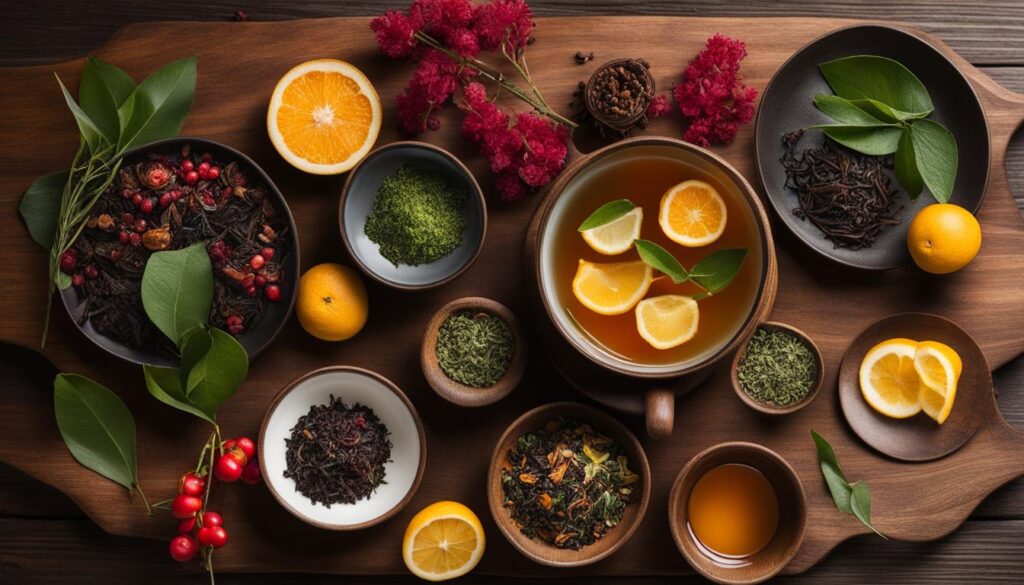
Tea Flavors for Different Seasons
| Season | Recommended Tea | Description |
|---|---|---|
| Summer | Fruit-infused iced tea | Refreshing and cooling with fruity flavors |
| Winter | Black tea or spiced chai | Comforting and warming with robust flavors |
| Spring | Floral teas (jasmine, rose) | Delicate and fragrant, capturing the essence of spring |
| Fall | Oolong tea or chai blends | Earthy and warming, perfect for cozy autumn days |
Enhancing Wellness Through Tea Selection
Tea is not just a beverage; it can also contribute to our overall well-being. Different types of teas offer various health benefits that can enhance our physical and mental wellness. From aiding digestion to providing calming effects, tea has the power to improve our well-being in many ways.
One way to incorporate tea into our meals is by using herbal teas in salads. Not only do they add flavor and depth to the dish, but they also offer additional health benefits. Chamomile or mint teas, for example, can aid digestion and provide a refreshing touch to salads. By choosing herbal teas known for their specific health benefits, we can create a nutritious and flavorful meal.
When selecting teas for health-conscious meals, it’s important to consider their antioxidant and nutrient content. Green tea, for instance, is rich in antioxidants called catechins, which can help protect our cells from damage and reduce the risk of chronic diseases. Matcha, a powdered form of green tea, is particularly high in antioxidants due to the way it is grown and processed. By incorporating these teas into our meals, we can boost our nutrient intake while enjoying their delicious flavors.
So the next time you’re planning a meal, don’t forget to consider the health benefits of tea. Whether you’re using herbal teas in salads or choosing teas with specific antioxidants, tea selection can play a crucial role in enhancing your wellness. Embrace the power of tea and experience the positive impact it can have on your overall well-being.
Exploring the World of Tea Flavors
Tea lovers rejoice! The world of tea flavors is full of delightful surprises and tantalizing combinations. From fruit-infused teas to floral blends and even dessert-inspired creations, flavored teas offer a whole new dimension to your tea-drinking experience. Let’s dive into the exciting world of flavored teas and discover the endless possibilities.
When it comes to fruit-flavored teas, you can expect a burst of refreshing and tangy flavors. Imagine sipping on a juicy peach tea on a hot summer afternoon or indulging in a zesty citrus blend. Fruit-flavored teas bring a playful twist to traditional flavors, making each sip a pure delight.
“Tea is like a hug in a cup.” – Anonymous
For those seeking a more delicate and aromatic profile, floral teas are a perfect choice. Experience the blissful notes of lavender, chamomile, or rose petals dancing on your palate. These teas not only offer a lovely taste but also envelop you in a soothing and calming aroma, creating a truly serene tea-drinking experience.
And let’s not forget about dessert teas! Indulge your sweet tooth with flavors like chocolate, caramel, or vanilla. Imagine savoring a steaming cup of chocolate cake tea, complete with the aroma and taste of freshly baked goodness. Dessert teas bring the essence of your favorite treats into your teacup, providing a guilt-free indulgence.
Tea Flavor Profile Guide
| Tea Flavor | Description |
|---|---|
| Fruit-Infused | Tangy, refreshing, and bursting with fruity flavors |
| Floral | Aromatic, delicate, and soothing with floral notes |
| Dessert-Inspired | Sweet, decadent, and reminiscent of your favorite treats |
An exploration into the world of flavored teas opens up a whole new realm of taste sensations. Whether you’re looking to add some fruity freshness, indulge in the elegance of floral notes, or satisfy your dessert cravings, there’s a flavored tea waiting to be discovered. So go ahead, embark on a flavor-packed journey and let your taste buds revel in the magic of flavored teas.
Conclusion
In conclusion, selecting the ideal tea for your meals is a delightful journey that can elevate your dining experience. By following our tea selection guide and considering the flavors and pairings, you can find the perfect match for any dish.
From seafood meals to meat-based dishes, ethnic cuisines to health-conscious choices, the world of tea offers a wide variety of flavors to complement different cuisines and courses. Whether you prefer a refreshing green tea with your seafood or a robust black tea with your steak, there’s a tea out there for every taste and preference.
So, embrace the art of tea selection and let your taste buds explore the exciting world of flavors. Don’t be afraid to experiment and create your own personalized tea experience for your meals. Cheers to the perfect cup of tea!
FAQ
How do I select the right tea for my meals?
Consider the characteristics of different teas, such as black, green, white, herbal, and iced, and choose based on the flavors you want to enhance.
What are the different brewing methods for tea?
Black tea, green tea, white tea, oolong tea, herbal tea, and iced tea all require specific brewing methods to bring out their best flavors.
How do I pair tea with different cuisines?
For seafood meals, consider lighter teas like green or white tea. For meat-based meals, black teas can provide a bold contrast. Ethnic cuisines require choosing teas that enhance the dominant flavors and spices.
Can I enjoy tea throughout a meal?
Yes, lighter teas like green or white tea can awaken the palate during appetizers, while main courses and desserts can be paired with teas that complement the flavors and intensity of the dishes.
How do I choose tea flavors that match the season?
In summer, choose refreshing iced teas or fruity herbal teas. In winter, opt for warming teas like black tea or spiced blends. Spring calls for floral or light green teas, while fall flavors include earthy and warming teas like oolong or chai.
What health benefits can I get from tea?
Different types of teas offer various health benefits. Herbal teas can aid digestion and provide calming effects. Incorporating tea into salads can add flavor and nutrients. Choosing teas known for their antioxidants and nutrients can enhance wellness.
Are there flavored teas available?
Yes, flavored teas offer a delightful twist to traditional options. Fruit-flavored teas can be refreshing and tangy, floral teas offer a delicate and aromatic profile, and dessert teas can satisfy sweet cravings with flavors like chocolate or caramel.
How can I enhance my dining experience with tea?
By considering factors such as the type of tea, brewing methods, and pairing options, you can find the perfect tea to complement your meals and create a memorable dining experience.

